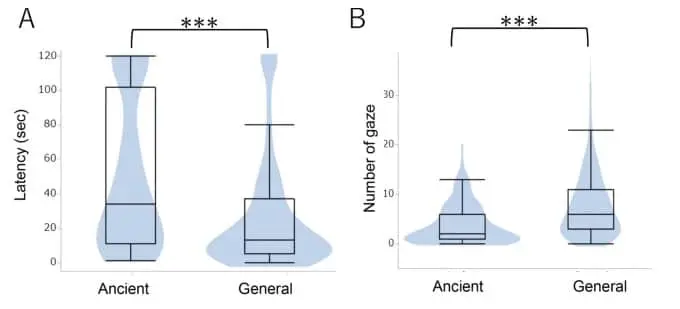domestic dogs (Canis lupus familiaris) are the oldest and most popular pets; modern dog breeds were domesticated into human society over 10,000 years ago! However, the process of domestication remains to be clarified. Less aggressive than wolves, closer to humans, dogs are also able to communicate with them. What are the biological mechanisms at the origin of this fundamental difference? A new study sheds light on the genetic differences involved.
Today there are more than 400 breeds of domestic dogs. The dogs are believed to have been bred for their human closeness, physical traits, demeanor and, more broadly, their ability to form social relationships. The genetic basis for these abilities is not well understood, however, and a team from the Department of Veterinary Science at Azabu University, Japan, has looked into the matter.
” It is certain that these behavioral adaptations, including docility and the ability to socialize with humans, are important factors that have allowed the integration of the dog into human society. “, write the researchers in Scientific Reports. They found that two mutations in a specific gene — which is involved in the production of cortisol — may have played a role in the domestication of dogs, allowing them to develop social cognitive skills to interact and communicate with people. humans.
Social abilities related to the endocrine system
Namely, animal behavior, especially social behavior, is modulated and influenced by the actions of various hormones in the brain. For example, glucocorticoids (cortisone and cortisol) are hormones positively linked to anxiety and social avoidance. Therefore, they may have played a role in the domestication process, just like oxytocin. The latter is a hormone widely involved in the attachment between a female and her offspring in mammals. Studies have shown that oxytocin can also mediate interspecies relationships; it is what allows dogs to respond to human social cues, such as pointing.
Genomic research has identified a list of genes that have undergone positive selection during domestication; the functions of these genes are very diverse (digestion, reproduction, neurological processes, etc.). ” Some of these selections may have influenced the endocrine system, leading domestic dogs to acquire their unique behaviors during the process of domestication. “, note the researchers. They therefore further investigated the role of cortisol and oxytocin in this process.
Miho Nagasawa and his colleagues started by studying the social and cognitive interactions of 624 domestic dogs by subjecting them to two tasks. In the first, the dog had to decide which of two bowls contained food hidden under it, based on cues such as staring, pointing and tapping, provided by the experimenters. This task was designed to test the dog’s understanding of gestures and human communication.
In the second task, the dog was given a problem-solving test, which involved trying to open a container to access food. During the task, the frequency and duration of the dog’s gaze at the experimenters was measured, in order to assess social attachment to humans. The dogs were separated into two groups based on their breed: the Old Breed group, made up of breeds considered genetically closer to wolves, such as the Akita and Siberian Husky; and the general group, which encompasses all other races.
An attachment that stems from genetic mutations
It emerged from this experiment that during the problem-solving task, older breed dogs showed longer latency before looking at the experimenters; furthermore, they looked less often at humans than other races—suggesting that they were less attached to them overall. The researchers, on the other hand, report no significant difference linked to race during the first task, neither in the rate of correct answer, nor in their ability to understand human gestures and signals.

 100vw, 680px”/>
</picture>
</noscript><figcaption id=) Heirloom dogs stare at humans less often than other breeds. © A. Tonoike et al.
Heirloom dogs stare at humans less often than other breeds. © A. Tonoike et al.” We hypothesized that cortisol’s regulation of social tolerance and non-fearful response to humans may have been the most important turning point in dog domestication. “, explain the researchers. However, a decrease in cortisol alone cannot explain dogs’ ability to understand human communication cues and form social bonds; the team therefore suspected that oxytocin was also involved in the domestication process.
They then examined, in each of the two groups, the genetic polymorphisms of oxytocin, the oxytocin receptor, the melanocortin 2 receptor (MC2R) and a gene linked to Williams-Beuren syndrome, as as candidate genes for dog domestication. In humans, Williams-Beuren syndrome is a congenital disorder characterized, among other developmental difficulties, by hypersocial behavior; they feel a strong need to love and be loved. However, unlike wolves, domesticated dogs have specific genetic insertions at the level of chromosome 6, in the critical region of this syndrome – which explains their extreme sociability.
Data analysis shows that two mutations in the MC2R gene, involved in cortisol production, are both associated with correctly interpreting gestures in the first task and with looking more often at experimenters in the solving task. of problems. This gene could therefore have played a role in the domestication of dogs, perhaps by promoting lower levels of stress in the company of humans.
However, further research will be needed to substantiate this finding. The team believe that the social cognitive skills of domestic dogs cannot be fully explained by the genes identified here alone, but must be controlled by other genes, the effects of which will need to be determined.